65 Interesting Statistics About Reading 2025 (Success & Benefits)

Why are facts about literacy important?
Have you read a book lately?
This year, we are grateful to be back to the busyness of normal life. But between work, school, and activities, the simpler pleasures of life may have been left behind.
If you need an excuse to grab a book, check out these facts and statistics about reading in 2023 that will have you back into the reading habit in no time (and some will shock you too!)
Reading Statistics in the United States
Literacy influences how we learn, make decisions, work, and socialize in the community with others.
The literacy rate refers to the percentage of people who can both read and write. The adult literacy rate measures literacy among persons age 15 and older. (UNESCO)
So what are the statistics on the benefits of reading? And where do Americans stand?

Would you like to save this idea?
1. 43 million US adults possess low literacy skills.
According to the National Center for Education Statistics, about four out of five U.S. adults (79%) have medium to high English literacy skills. These literacy levels are sufficient to compare and contrast information, paraphrase, and make low-level inferences.
This means that about one in five U.S. adults (21%) have low literacy skills, translating to about 43.0 million adults. (NCES)
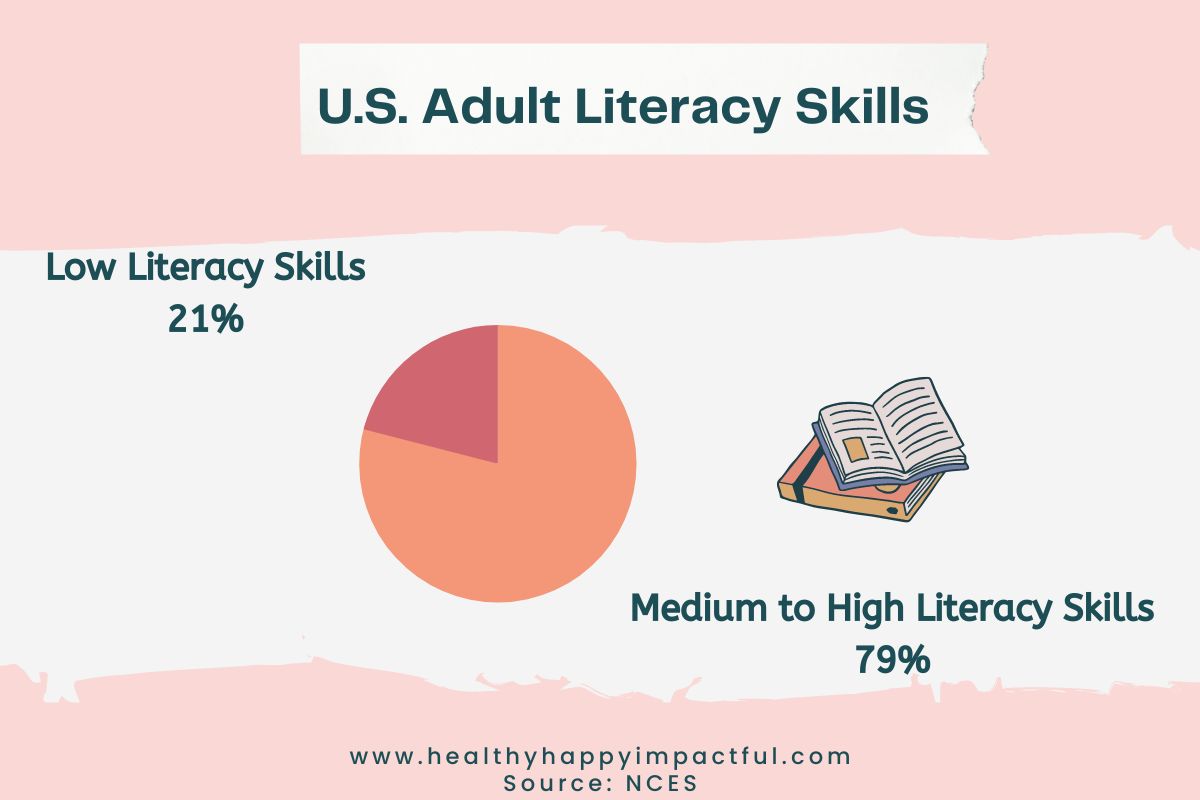
2. According to the U.S. Department of Education, 54% of U.S. adults ages 16-74 lack proficiency in literacy, reading below the equivalent of a sixth-grade level. That is about 130 million people. (Forbes)
3. New Hampshire, Minnesota, North Dakota, Vermont, and South Dakota are the top 5 states in terms of literacy rates in 2022. (World Population Review)
4. California, New York, Florida, Texas, and New Jersey are the 5 lowest states in term of literacy rates in 2022. (World Population Review)
A low literacy rate has huge economic impacts as well as impacts on our next generation.
5. While you might think that the United States is at the forefront of literacy and education, it ranks 125th for literacy rate among all countries. (IMSE Journal)
6. Low literacy is said to be connected to over $230 billion a year in health care costs because almost half of Americans cannot read well enough to comprehend health information. (American Journal of Public Health)
7. Low literacy also costs the U.S. at least $225 billion each year in non-productivity in the workforce and loss of tax revenue due to unemployment. (IMSE Journal)
8. According to Forbes magazine, Low Literacy Levels Among U.S. Adults Could be Costing the Economy $2.2 Trillion A Year. Literacy is correlated with personal income, employment levels, health, and overall economic growth. (Forbes)
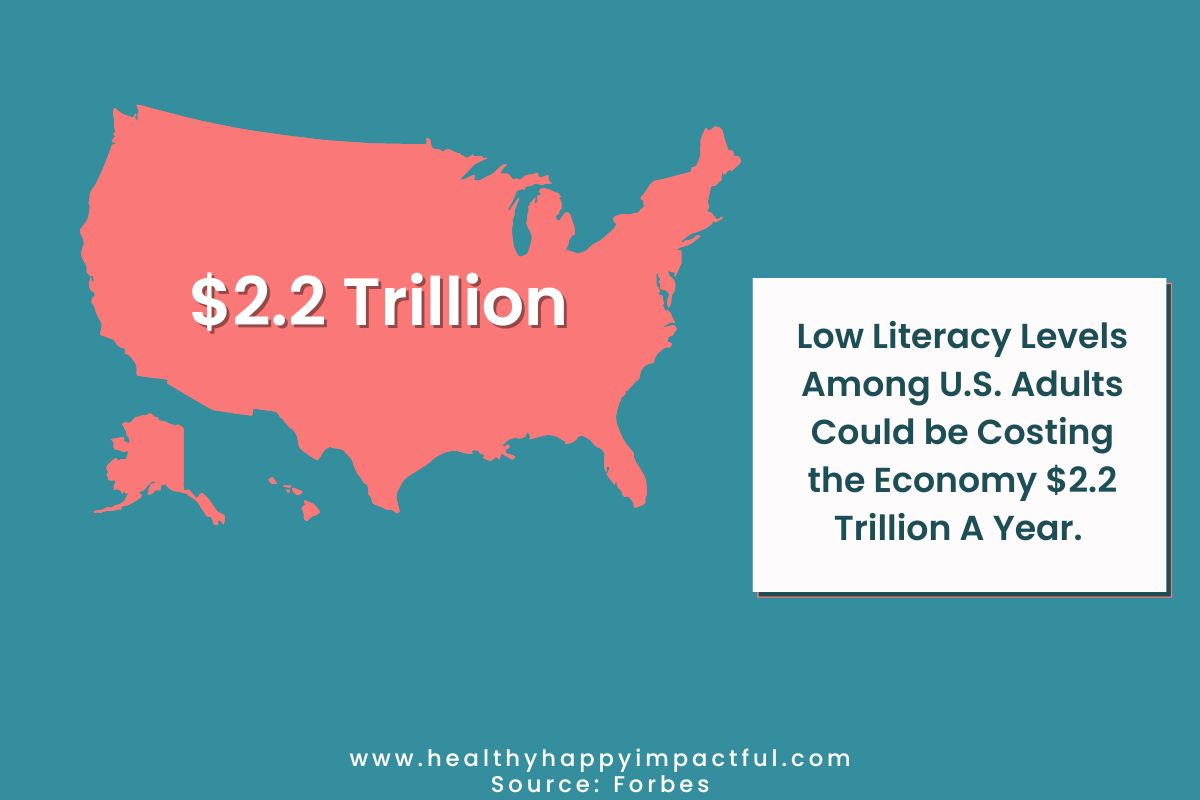
Are people reading less than before?
9. The average number of books read per year by an American is 12. The median across all populations is 4 per year. That means if you read more than 4 books per year, you’re reading more than half the country. (Pew Research Center)
Unfortunately, U.S adults are reading roughly two or three fewer books per year than they did between 2001-2016. (Gallup)
10. 50% of adults cannot read a book written at an eighth-grade level. (Literacy Project)
11. What age group reads the most? In 2021, adults over the age of 75 spent over 40 minutes reading each day. In contrast, teenagers between 15 and 19 years read for less than 10 minutes per day on average. (Statista)
12. On average, the daily time spent reading among American adults was just over 16.8 minutes in 2021. This is a 26% decrease from 2005 when Americans read an average of 22.8 minutes per day. (Statista)
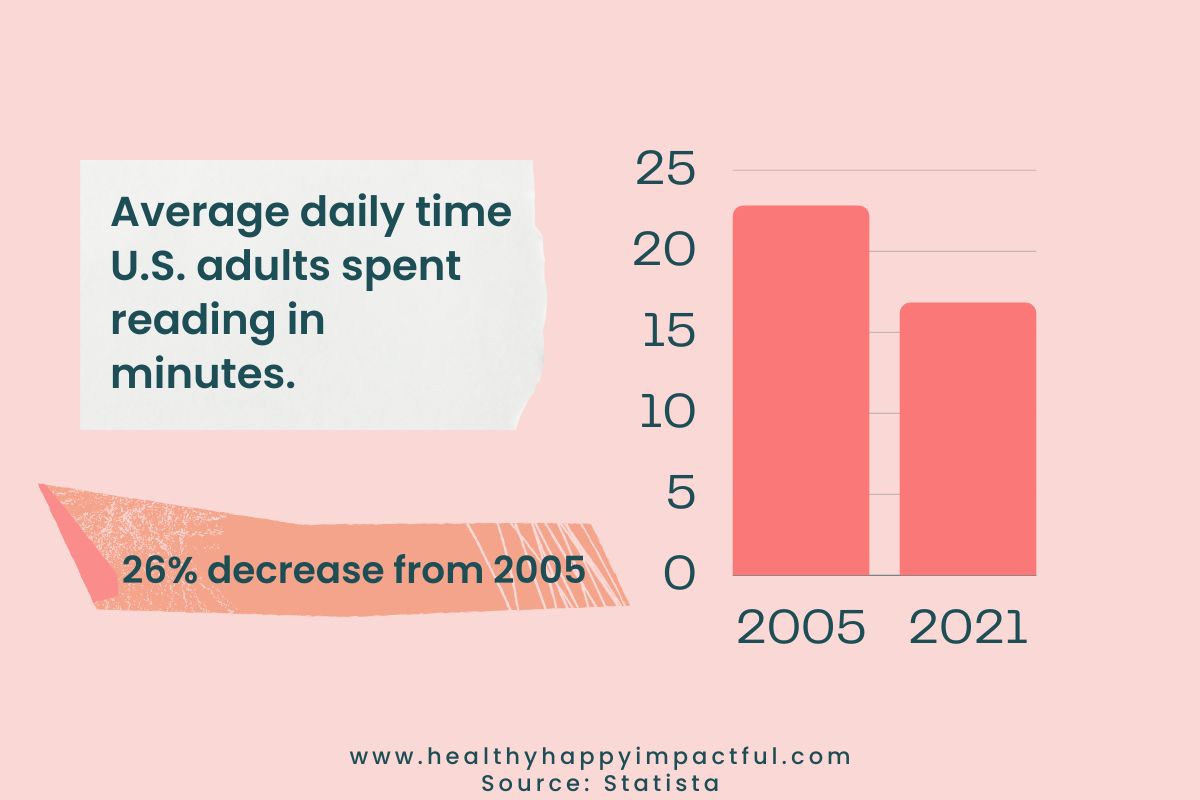
Related: Best Books To Start A Good Reading Habit
Statistics About Reading Benefits
13. Reading could help reduce mental decline in old age by 32%. (Neurology)
14. Reading can reduce stress up to 68%. More so than listening to music, having a cup of tea, or taking a walk. (University of Minnesota)
15. 19% of readers say spending time with a book makes them feel less lonely. (Toner Buzz)
16. Reading for as little as 6 minutes slows heart rates and eases tension. (Toner Buzz)
17. Reading is 300% better at reducing stress than walking and 700% better than playing video games. (Toner Buzz)
18. Lifelong readers have lower rate of Alzheimer’s and other forms of dementia than their peers. (Toner Buzz)
19. 50% of people who read before bed report better sleep than non-readers. (Toner Buzz)
20. Reading fiction is a way to improve language development and vocabulary as well as brain connectivity and function. It also increases are empathy toward others. (Toner Buzz)
Reading Statistics For Kids
We know that young kids become better readers with practice. Just this week, my son’s first-grade teacher sent home a book packet to record everything we’re reading.

So, what are the benefits of reading aloud to our children? And what percentage of kids are struggling readers? Let’s find out!
21. The more students read (or are read to) for fun on their own time and at home, the higher their reading scores. (Department of Education)
22. In 2018, 77% of parents read to their child before their first birthday. (Scholastic)

23. Reading statistics show 83% of children love or like being read to a lot. 86% of parents feel the same. (Scholastic)
24. 55% of children ages 0-5 are read books aloud at home at least five days a week. 45% of 6-8 year-olds are read aloud to at home at least five days a week. (Scholastic)
25. Among parents of children ages 0-8 who are read aloud to, 94% include it as part of a routine such as bedtime and naptime. (Scholastic) – Find great bedtime stories here>>
“Read–aloud is a prescription for lifelong success for the child and a dose of deep well-being for the family.“
– Pam Allyn, Senior Vice President, Innovation & Development, Scholastic Education
26. 93% of moms read to their 0-11 year-olds compared to 79% of dads. (Scholastic)
27. 35.34% of students are reading at or above a proficient level in Grade 4 in 2019. (NCES)
The National Assessment of Educational Progress (NAEP) assessment in reading comprehension is given every two years to students in grades 4 and 8, and approximately every four years at grade 12. The assessment measures reading comprehension by asking students to read selected grade-appropriate materials and answer questions based on what they have read.
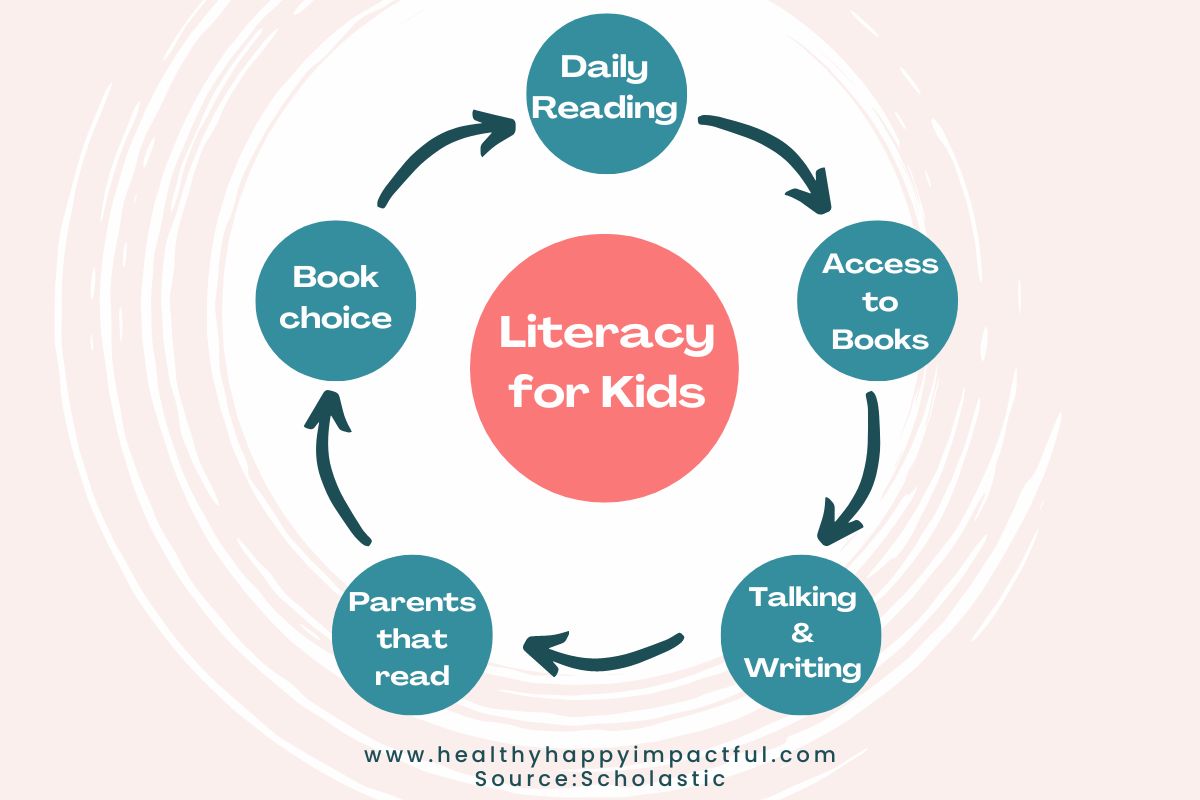
28. 33.58% of students are reading at or above a proficient level in Grade 8 in 2019. (NCES)
29. 37% of students are reading at or above a proficient level in Grade 12 in 2019. (NCES)
30. 6 additional minutes of reading per day can significantly improve kids’ reading performance.(Renaissance)
Encourage your kids to read with:
- kids books that are also movies
- the most inspiring kids books
- interactive kids books (sound, flaps, and more!)
31. Children who read at least 20 minutes a day are exposed to almost 2 million words per year. (Every Child Reads)
32. Teenage reading statistics show over 80% of them don’t read for pleasure on a daily basis. (APA)
33. 58% of kids in a 2018 report say they love/like reading books for fun a lot. (Scholastic)
Related: Best Kids Reading Quotes

34. Reading frequency and enjoyment declines as kids grow. By age 9, only 35% of kids report reading 5-7 days a week compared to 57% of eight-year-olds. (Scholastic)
Find great books for 9 year olds >>
35. 82% of frequent readers say a lot or nearly everyone they know enjoys reading. (Scholastic)
36. Frequent readers have an average of 139 books in their homes vs. 74 in infrequent readers’ homes. Families with incomes of $100,000 or more have nearly twice the amount of books than families with less than $35,000 in annual income (125 vs. 73) (Scholastic)
37. Four in Ten kids agree that they have trouble finding books they like. (Scholastic)

38. The top 3 states for highest child literacy rates were Massachusetts, Maryland, and New Hampshire in that order. (Think Impact)
39. The bottom 3 states for child literacy rates were Louisiana, Mississippi, and New Mexico. (Think Impact)
40. The number of books in the home correlates significantly with higher reading scores for children. (Think Impact)
41. 89% of children ages 6-17 across demographics agree their favorite books are the ones they have picked out themselves. (Scholastic)
Find the best 6 year old books and best books for 7 year olds >>
42. 88% say they are more likely to finish a book they have picked out themselves and 82% say they feel a sense of accomplishment when they finish reading a book. (Scholastic)
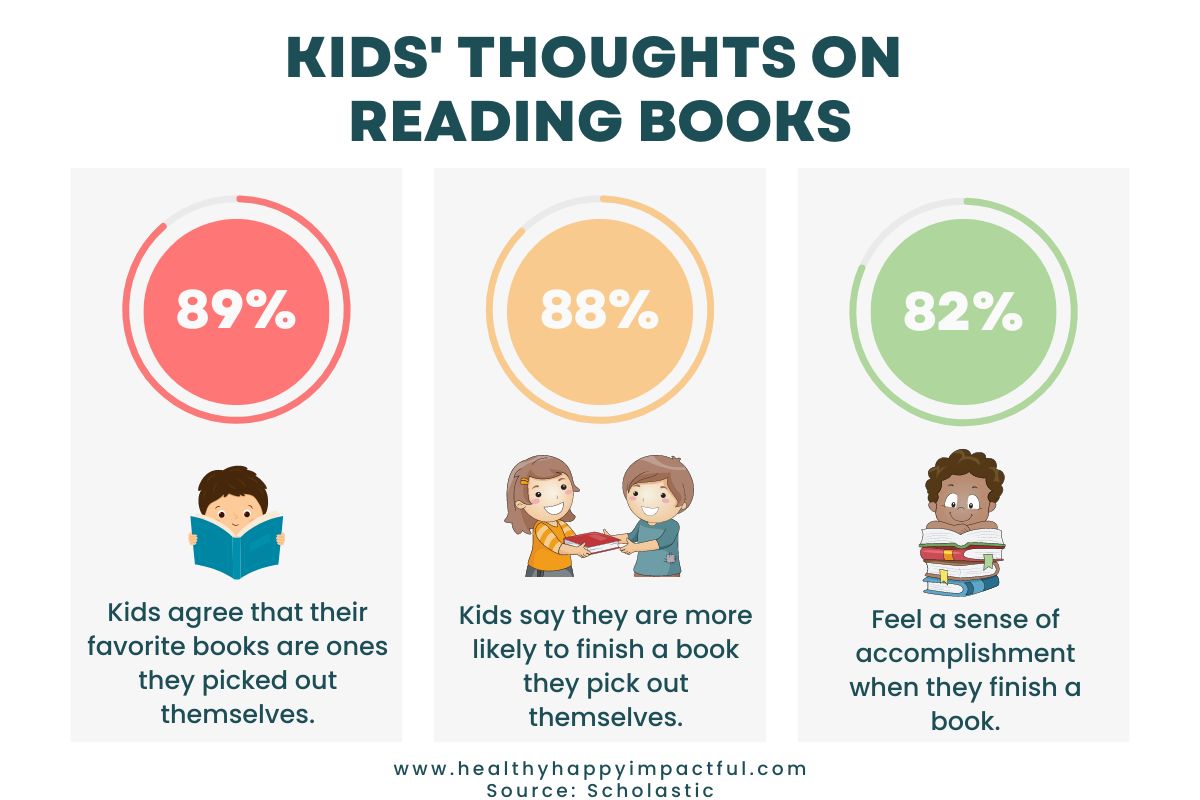
Need help getting kids motivated? Don’t miss our free reading challenge all year!
Statistics About Reading and Success
What does this information mean for the future success of children? As you’ll see below, there’s plenty of evidence correlating literacy and achievement.
43. Reading increases emotional intelligence, and consequently, your career outlooks. (CNBC)
44. 86% of people with an annual household income of $75,000 a year read at least one book every year (Statista)
45. Only 70% of those earning less than $30,000 a year reported reading at least one book a year. (Statista)
46. The average annual income of adults who are at the minimum proficiency level for literacy is $63,000. The average annual income earned by adults who are just below proficiency is $48,000. Those at the lowest levels of literacy earn just over $34,000 on average. (Forbes)

47. 3 out of 5 people in American prisons can’t read and 85% of juvenile offenders have problems reading. (Literacy Project)
48. Bill Gates claims to read over 50 books a year (Business Insider)
49. Warren Buffett reports spending five to six hours a day reading different newspapers. (Business Insider)
50. Oprah Winfrey has called reading “her personal path to freedom” while advising followers on her reading habits with Oprah’s Book Club. (Business Insider)
Statistics On Reading Books
So, do you prefer an e-book or a paperback? These kindle reading statistics and book statistics may surprise you.

51. During a survey held in 2021, it was found that 83 percent of adults between 18 and 29 years old had read a book in any format in the previous year, up by two percent from the same survey held 2 years ago. The survey results showed that adults within this age category were more likely than older respondents to have read a book within the last twelve months. (Statista)
52. Despite the rise of digital platforms and the rising popularity of e-reading devices such as Kindle, Kobo and others, print books remain the most popular format for reading, with 65% of adults saying that they have read a print book in the past year. (Statista)
53. 30% of Americans have read an e-book in the past 12 months. (Pew Research Center)
54. 75% of U.S. adults say they have read a book in the past 12 months in any format. (Pew Research Center)
55. In 2021, 33% of Americans read in digital formats and also read print books, while 32% say they read only print books. Just 9% of Americans say they only read books in digital formats and 23% have not read any print books in the past 12 months. (Pew Research Center)
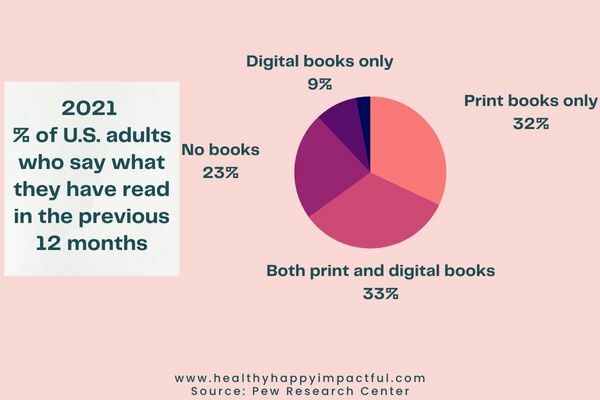
56. The U.S. books market is expected to generate $30 billion by 2025. (Toner Buzz)
57. 22% of US readers use e-readers, like a Kindle or a Nook, to read e-books. (Toner Buzz)
58. The average U.S. household spends $118 on reading annually, including newspapers and magazines. (Toner Buzz)
59. 88% of college graduates are especially likely to say they read books in any format in the past year. (Pew Research Center)
60. 78% of women and 73% of men read a book in any format in the past year. (Pew Research Center)
Related: Top Inspirational Books For Women
Other Interesting Books Facts in 2023
61. Over the last 50 years, the best-selling book has been the Bible. (USA Today)
62 . The bestselling book of last year in all categories was Dav Pilkey’s “Dog Man: Mothering Heights” (USA Today)
63. The second bestselling book last year was Kristin Hannah’s “The Four Winds“. (USA Today)
64. Coming in third was “American Marxism” by Mark Levin. (USA Today)
65. Top 3 bestselling books of all time: (Business Insider)
- The Bible- 5 billion copies registered by Guinness World Records in 2021.
- The Works of Mao Tse-tung– 820 million copies
- The Harry Potter Series– 500 million copies
*Don’t miss these fun book trivia questions and answers!
To Consider With Reading Statistics

These statistics about reading show that it’s extremely beneficial for us. Reading gives adults and children a more successful future, as well as better mental, emotional, and physical health.
What are you waiting for? Go ahead. Pick up that book today!
Sources
NCES (1)
Forbes (2, 8, 46)
World Population Review (3, 4)
American Journal of Public Health (6)
IMSE Journal (5, 7)
Pew Research Center (9, 53, 54, 55, 59, 60)
Gallup (9)
Literacy Project (10, 47)
Statista (11, 12)
Neurology (13)
Toner Buzz (15, 16, 17, 18, 19, 20, 56, 57, 58)
Scholastic (22, 23, 24, 25, 26)
NCES (27, 28, 29)
Renaissance (30)
Every Child Reads (31)
APA (32)
Scholastic (33, 34)
Scholastic (35, 36, 37, 41, 42)
Think Impact (38, 39, 40)
CNBC (43)
Statista (44, 45)
Business Insider (48, 49, 50)
Statista (51, 52)
USA Today (61, 62, 63, 64)
Business Insider (65)
Other HHI Posts You’ll Love…
- 35 Best 3 Year Old Books to Read Aloud
- Best Kindness Books For Kids List
- Best Books For Halloween & Christmas Picture Books Kids Love


I love reading books and I can escape and it relaxes me. reading calms me and centers my soul when I feel lost and discombobulated. I always have a book with me when I am not at home and most people I associate with are readers like myself. I was once in a book group which I’d like to again. No better hobby to me than reading or curled up in bed with a good book. i always have authors that i can suggest to someone else in my head. I get reading suggestions from others as well. Reading makes for a good conversation and increases your vocabulary.
Tanya, Thank you for sharing! I agree that reading is the best hobby!